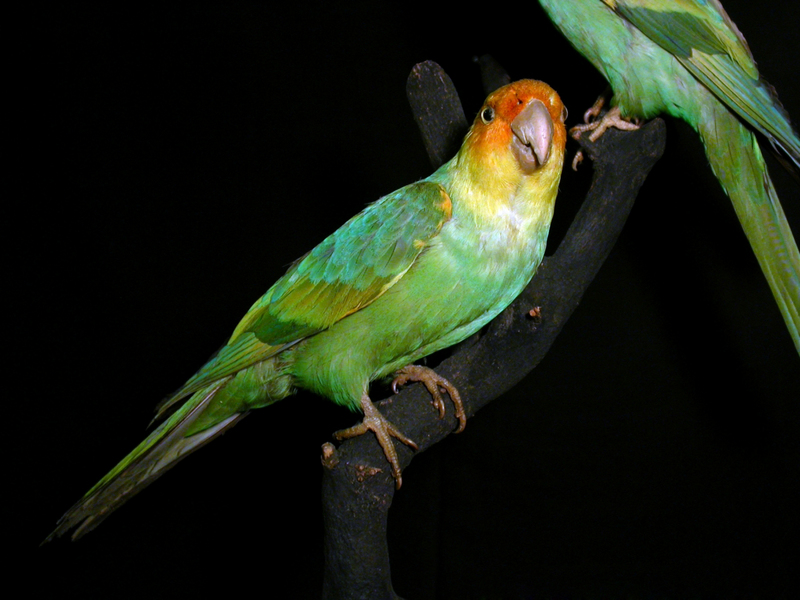Carolina Parakeet (Conuropsis carolinensis) - Wiki Carolina Parakeet
From Wikipedia, the free encyclopedia
[Photo] Conuropsis carolinensis, mounted specimen, Museum Wiesbaden, Deutschland, Germany. Date 2005. Author Fritz Geller-Grimm
The Carolina Parakeet (Conuropsis carolinensis) was the only parrot species native to the eastern United States. It was found from the Ohio Valley to the Gulf of Mexico, and lived in old forests along rivers. It was the only species at the time classified in the genus Conuropsis. It was called puzzi la nee ("head of yellow") or pot pot chee by the Seminole and kelinky in Chikasha (Snyder & Russell, 2002).
The last wild specimen was killed in Okeechobee County in Florida in 1904, and the last captive bird died at the Cincinnati Zoo in 1918. This was the male specimen "Incas," who died within a year of his mate "Lady Jane." The bird was officially declared extinct in 1939 however.
At some date between 1937 and 1955, 3 parakeets resembling this species were sighted and filmed in the Okefenokee swamp of Georgia. However, the American Ornithologists Union concluded after analyzing the film, that they had probably filmed feral parakeets. Additional reports of the bird were made in Okeechobee County in Florida until the late 1920s, but these are not supported by specimens.
Reasons for extinction
The Carolina Parakeet died out because of a number of different threats. To make space for more agricultural land, large areas of forest were cut down, taking away its living space. The colorful feathers (green body, yellow head, and red around the bill) were in demand as decorations in ladies' hats, and the birds were kept as pets. Even though the birds bred easily in captivity, little was done by owners to increase the population of tamed birds. Finally, they were killed in large numbers because farmers considered them a pest, although many farmers valued them for controlling invasive cockleburs.
A factor that contributed to their extinction was the unfortunate flocking behavior that led them to return immediately to a location where some of the birds had just been killed. This led to even more being shot by hunters as they gathered about the wounded and dead members of the flock.
This combination of factors extirpated the species from most of its range until the early years of the 20th century. However, the last populations were not much hunted for food or feathers, nor did the farmers in rural Florida consider them a pest as the benefit of the birds' love of cockleburs clearly outweighed the minor damage they did to the small-scale garden plots. The final extinction of the species is somewhat of a mystery, but the most likely cause seems to be that the birds succumbed to poultry disease, as suggested by the rapid disappearance of the last, small, but apparently healthy and reproducing flocks of these highly social birds. If this is true, the very fact that the Carolina Parakeet was finally tolerated to roam in the vicinity of human settlements proved its undoing (Snyder & Russell, 2002).
The Louisiana subspecies of the Carolina Parakeet, C. c. ludovicianus, was slightly different in color to the parent species, being more bluish-green and generally of a somewhat subdued coloration, and went extinct in much the same way, but at a somewhat earlier date (early 1910s). The Appalachians separated these birds from the eastern C. c. carolinensis
In museums
About 720 skins and 16 skeletons are housed in museums around the world (Luther, 1996). Of the 49 supposed egg specimens McKinley (1977) accepted 20 as certainly and 7 as probably correctly assigned to this species. 5 eggs controversially attributed to this species that were collected in Florida on April 30, 1927 (FSM 87234 - 3 eggs - and 89434 - 2 eggs). These are not accepted as valid by McKinley (1977) based on their small size and early date of collection, but molecular analysis could possibly determine whether these are in fact eggs of Carolina Parakeets.
A fossil parrot, Conuropsis fratercula, was described based on a single humerus from the Miocene Sheep Creek Formation (possibly late Hemingfordian, c.16 mya, possibly later) of Snake Creek, Nebraska (Wetmore, 1926). However, it is not altogether certain that this species is correctly assigned to Conuropsis (Olson, 1985), but some authors consider it a paleosubspecies of the Carolina Parakeet.
Parakeets in the US
Although the extinction of the Carolina Parakeet represents the irrevocable loss of North America's only truly indigenous parrot, from the 1960s onwards, an introduced species, Myiopsitta monacha, the Quaker Parakeet, Monk Parakeet, or Monk Parrot, began establishing flocks in several states, including New York, New Jersey, Connecticut, Rhode Island, Illinois, Florida, Louisiana, and Texas through accidental or intentional releases. Smaller feral colonies of several other species of parrots and parakeets have since established themselves in various locations of the USA, including downtown Pasadena. The African Lovebird has established itself in parts of the Phoenix metro area. The Mexican Thick-billed Parrot also used to range into Arizona before its population declined in the 20th century; attempts to reintroduce them have until now not met with any lasting success.
http://en.wikipedia.org/wiki/Carolina_Parakeet
| The text in this page is based on the copyrighted Wikipedia article shown in above URL. It is used under the GNU Free Documentation License. You may redistribute it, verbatim or modified, providing that you comply with the terms of the GFDL. |
